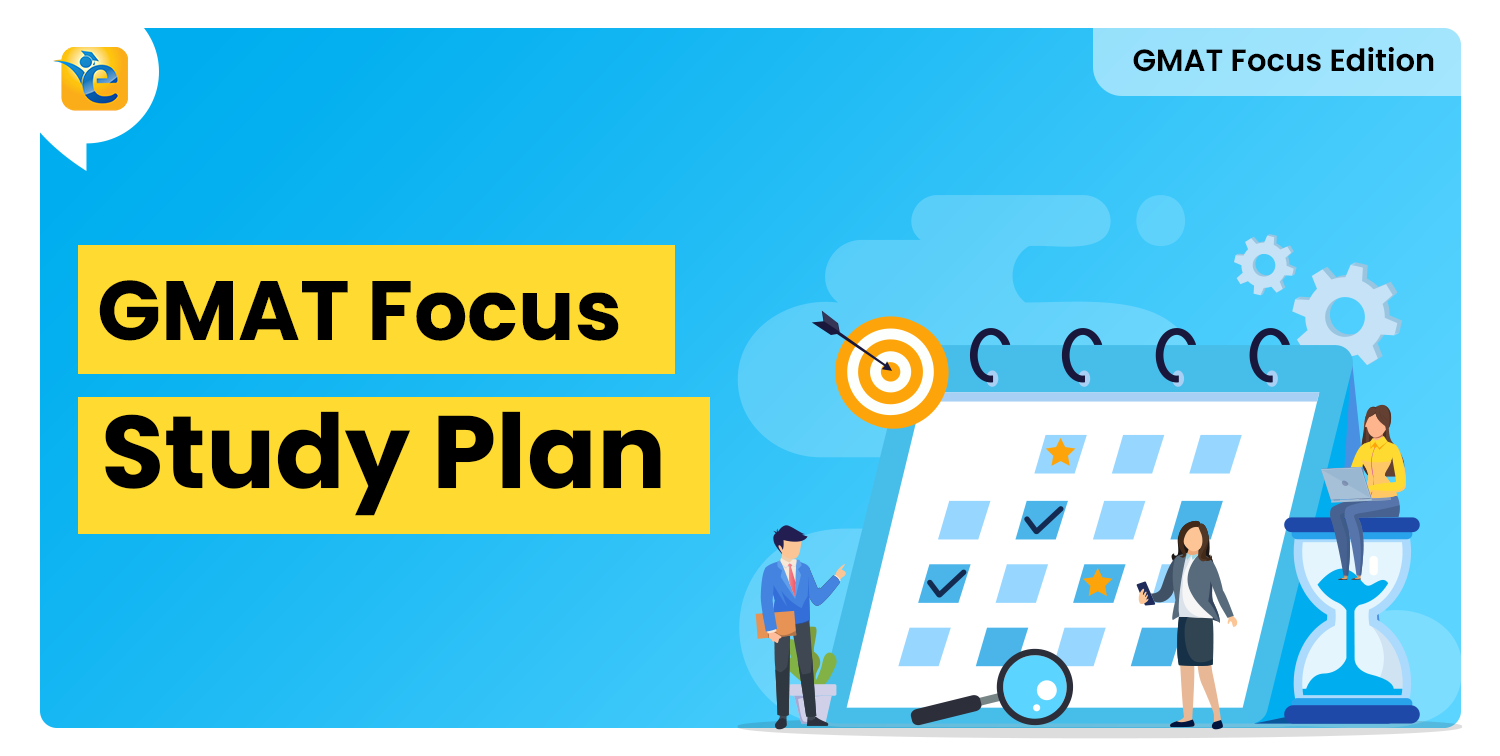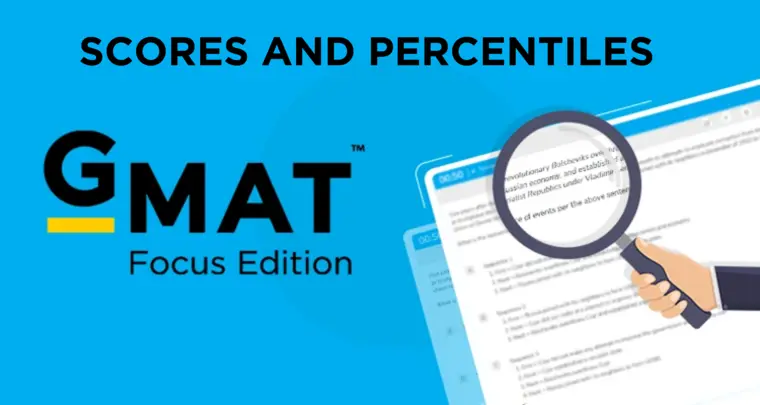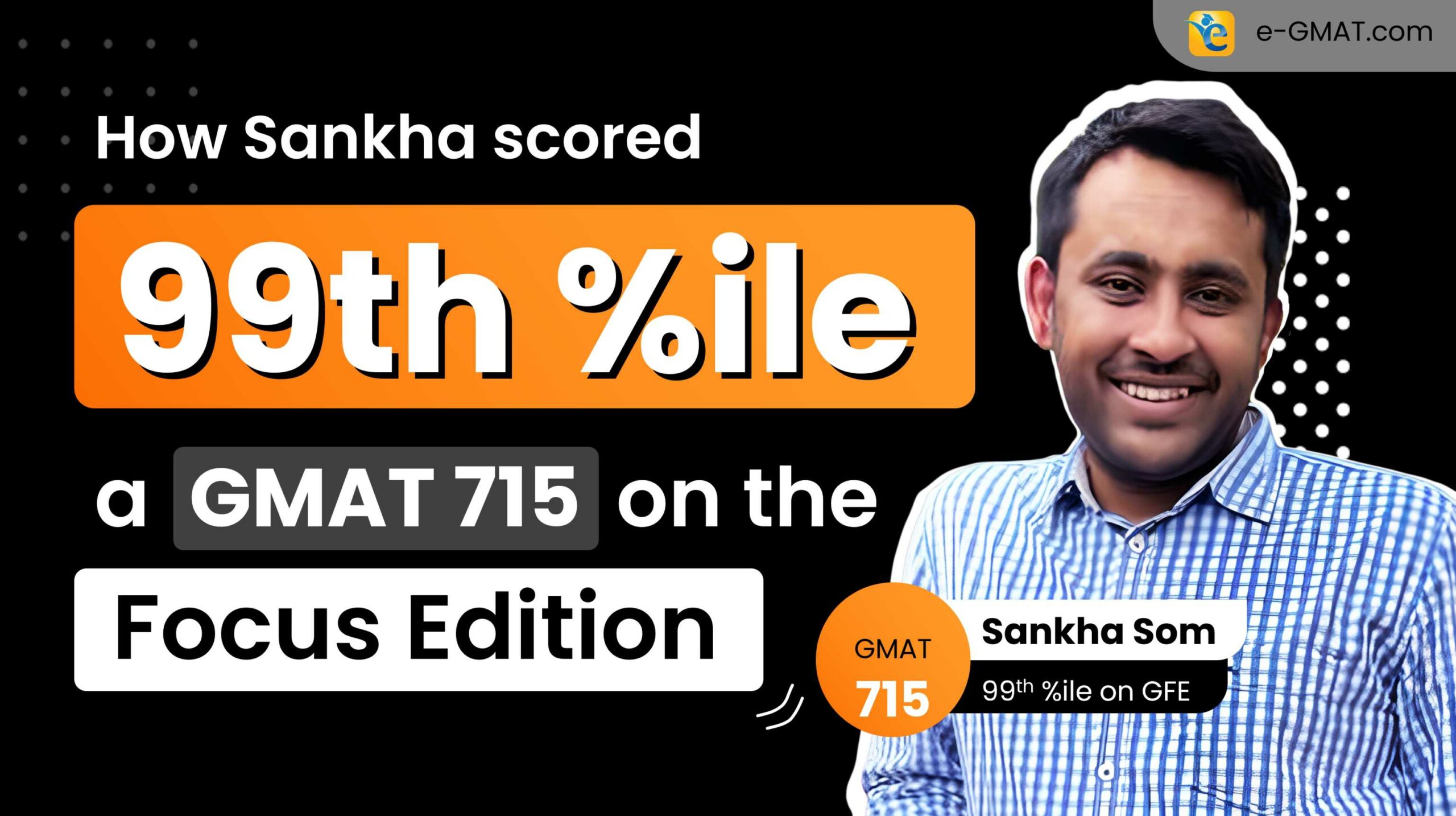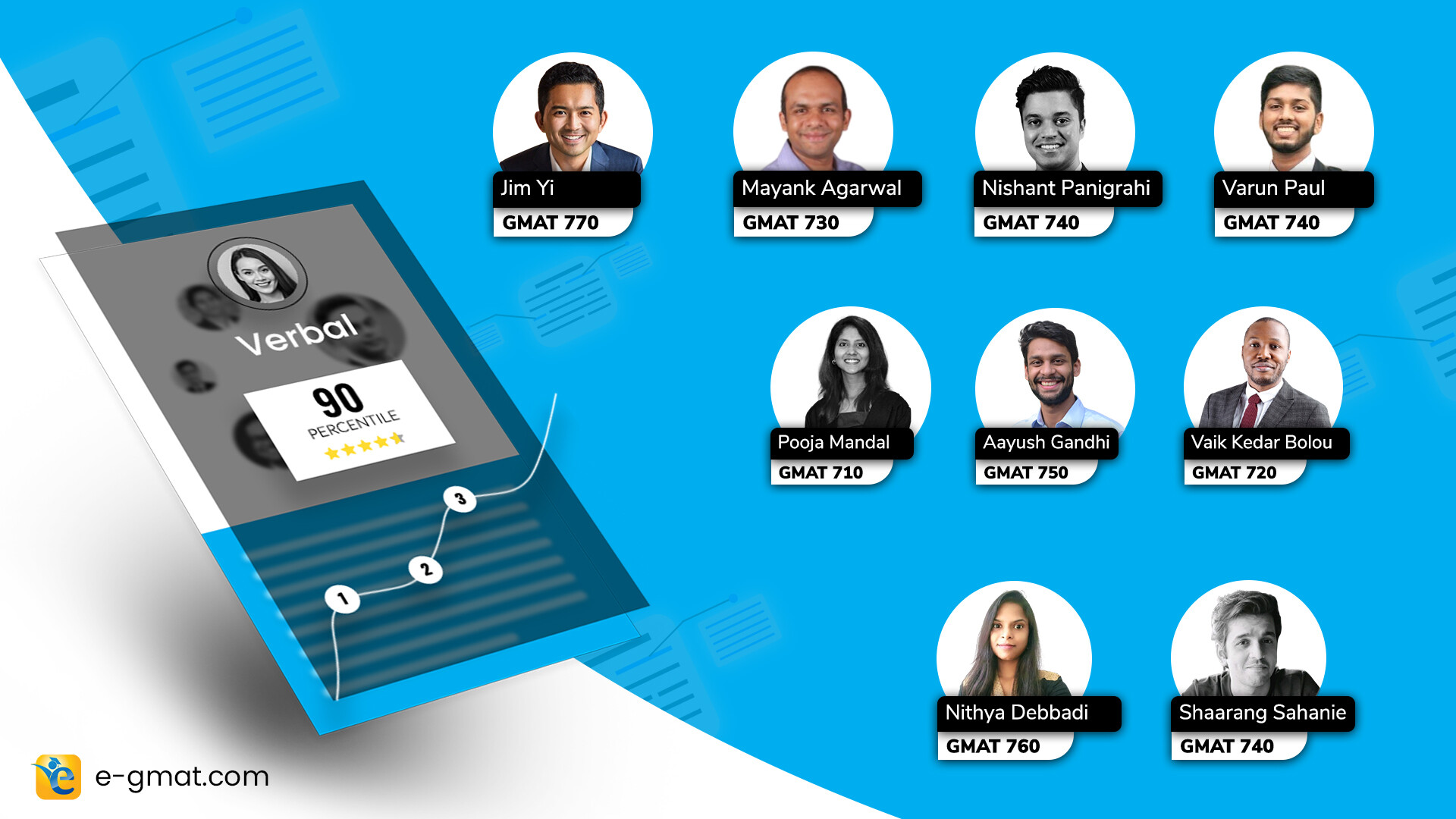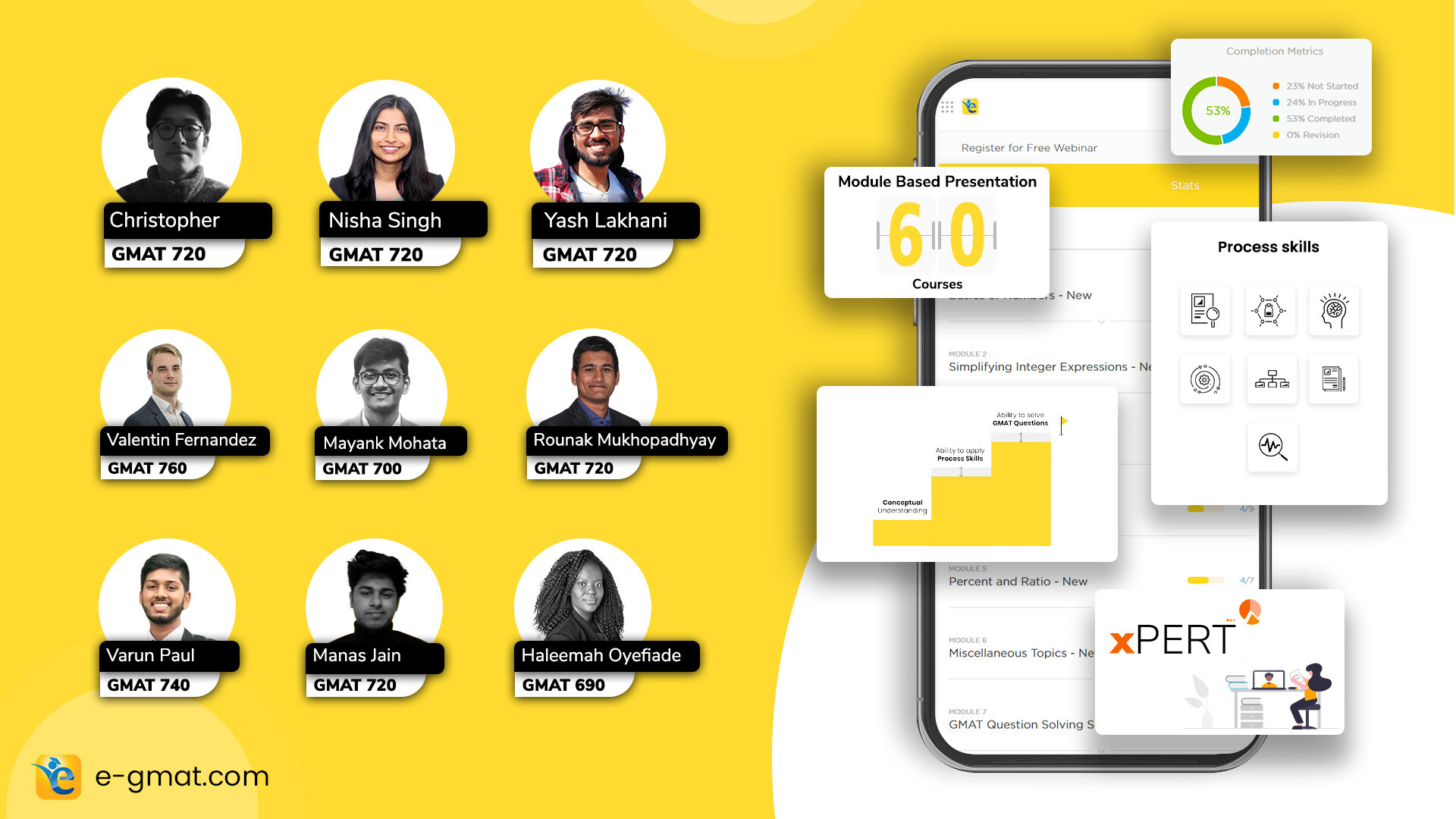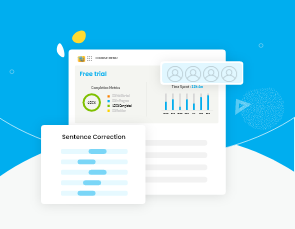You read the dataset perfectly. You set up your equations correctly. You even do the math right. But somehow, you’re still getting TPA questions wrong or taking way too long to solve them.
What’s happening?
You’re falling into the inference failure trap—the hidden killer that separates good GMAT scorers from great ones.
Key Takeaways: The Inference-First TPA Strategy
Here’s a reality check: Students who draw inferences first solve 60% faster than those who rely on answer choices. But most test-takers have never been taught how to systematically extract these game-changing insights from TPA datasets.
- Why smart approaches often backfire: Working backward from answer choices instead of forward from insights
- The dependency trap: How to recognize if you’re stuck in answer choice dependency
- Strategic elimination: How to shortlist answer choices before you calculate anything
- The systematic process: Four-phase framework for developing inferences that transform overwhelming problems into strategic victories
Today, I’m going to show you the exact inference techniques that transform overwhelming multi-variable problems into strategic victories. You’ll learn how to shortlist answer choices before you calculate, and more importantly, how to avoid the dependency trap that keeps smart students stuck in calculation quicksand.
⭐MASTER TPA STRATEGIC THINKING
Access our comprehensive TPA preparation resources including strategic frameworks, inference development techniques, and adaptive practice questions. Learn to think like a top scorer, not just calculate like one.
The Salvador Syndrome: When Smart Approaches Backfire
Let me tell you about Salvador (a real student from our sessions). Brilliant guy. Strong math background. But he kept struggling with TPA questions, and here’s what he told me:
“I started with the options below, got what’s needed, and then briefed through the stem.”
Salvador represents thousands of test-takers who have the right analytical instincts but apply them in the wrong order. He was working backward from answer choices instead of forward from insights.
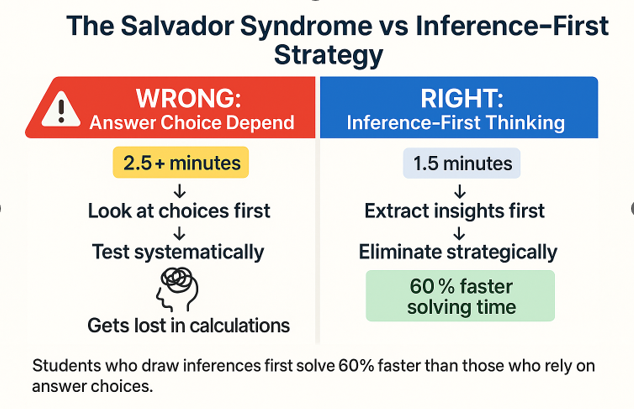
The result? He got lost in calculations, second-guessed himself, and ran out of time on questions he was fully capable of solving.
⭐ The core problem: Salvador was treating TPA questions like multiple-choice math problems instead of strategic reasoning challenges.
The Answer Choice Dependency Trap
Before we dive into solutions, you need to recognize if you’re trapped in answer choice dependency. Here are the warning signs:
You’re trapped if you:
- Look at answer choices before fully understanding the problem
- Try each option systematically until one “works”
- Feel overwhelmed when you see many variables
- Take longer than 2.5 minutes on most TPA questions
- Get different answers when you try different approaches
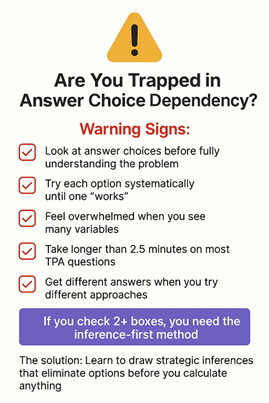
Why this approach fails:
- Answer choices often contain deliberate distractors
- You waste time on impossible combinations
- You never develop pattern recognition skills
- Time pressure increases your error rate
⭐ The solution: Learn to draw strategic inferences that eliminate options before you calculate anything.
The Corporate Expansion Breakthrough: Your First Inference Masterclass
Let’s start with a concrete example that shows the power of inference-first thinking.
Official Question:
A corporation recently expanded both its sales department and its technical department. Immediately before expansion, the number of employees in the sales department was exactly 60% of the number of employees in the technical department. Immediately after the expansion, the sales department had exactly 12 employees, and the technical department had exactly 15 employees.
Most students immediately start setting up equations:
- Sales before: 0.6T
- Sales after: 12
- Tech after: 15
Then they get stuck because they have more variables than equations.
But here’s the inference that changes everything:
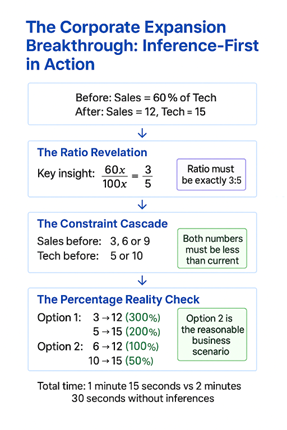
The Ratio Revelation
Before expansion: Sales = 60% of Tech = 60x, Tech = 100x
Key insight: 60x/100x = 3/5
This means the original ratio was exactly 3:5. Not approximately—exactly.
What this tells us:
- Sales employees before = multiple of 3
- Tech employees before = multiple of 5
- Both numbers must be less than current numbers (12 and 15)
The Constraint Cascade
From our ratio insight:
- Sales before: Could be 3, 6, or 9 (multiples of 3 less than 12)
- Tech before: Could be 5 or 10 (multiples of 5 less than 15)
- Note: 15 is impossible for tech before since it equals current number
Valid combinations maintaining 3:5 ratio:
- Option 1: 3 sales → 5 tech
- Option 2: 6 sales → 10 tech
The Percentage Reality Check
Option 1: 3→12 (300% increase) and 5→15 (200% increase)
Option 2: 6→12 (100% increase) and 10→15 (50% increase)
Looking at our choices answer, Option 2 (100% sales, 50% tech) is clearly the reasonable business scenario.
⏱ Time Comparison
With inferences: 1 minute 15 seconds
Without inferences: 2 minutes 30 seconds or more
The Theater Seating Power Play: Advanced Inference Techniques
Now let’s tackle a more complex scenario that demonstrates multiple inference types working together.
Official Question:
A certain theater has 500 seats. Some are on the main floor and sell for $50 each; some are in the first balcony and sell for $45 each; and the rest are in the second balcony and sell for $35 each. When all of the seats are sold for a performance, the gross revenue for that performance is $20,900. Of the three seating areas, the second balcony has the most seats.
Setting Up the System
Equations:
- M + F + S = 500 (total seats)
- 50M + 45F + 35S = 20,900 (total revenue)
- S > M and S > F (second balcony largest)
Most students immediately start trying to solve this system algebraically. That’s exactly where they get stuck.
Instead, let’s extract the key inference:
The Elimination Strategy
From our equations:
- M = 500 – F – S (substitute this into revenue equation)
- 50(500 – F – S) + 45F + 35S = 20,900
- 25,000 – 50F – 50S + 45F + 35S = 20,900
- -5F – 15S = -4,100
- F + 3S = 820
The Divisibility Insight
Here’s where most students miss the game-changing inference:
3S is always divisible by 3
820 ÷ 3 = 273.33… (NOT divisible by 3)
Therefore: F cannot be divisible by 3
Strategic Answer Choice Elimination
Looking at our F options:
- 100 (not divisible by 3) ✅
- 150 (divisible by 3) ❌
- 190 (not divisible by 3) ✅
- 250 (not divisible by 3) ✅
- 300 (divisible by 3) ❌
We’ve eliminated 2 out of 6 options before doing any calculations.
The Systematic Test
Now we test only the valid options:
- F = 100: 3S = 720, S = 240 (not in answer choices)
- F = 190: 3S = 630, S = 210 ✅ (both in answer choices)
- F = 250: 3S = 570, S = 190 (but we need S > F, so invalid)
Answer: F = 190, S = 210
⏱ Time Comparison
Time with inferences: 2 minutes
Time without inferences: 3 minutes 45 seconds
The Systematic Inference Development Process
Based on these examples, here’s your step-by-step framework for developing inferences:
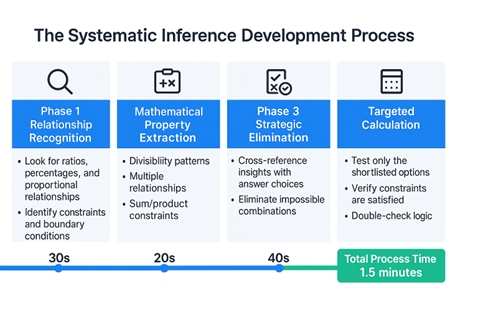
⚙️ Four-Phase Inference Framework
Phase 1: Relationship Recognition (30 seconds)
- Look for ratios, percentages, and proportional relationships
- Identify constraints and boundary conditions
- Spot patterns in coefficients or numbers
Phase 2: Mathematical Property Extraction (30 seconds)
- Divisibility patterns
- Multiple relationships
- Sum/product constraints
- Boundary value analysis
Phase 3: Strategic Elimination (20 seconds)
- Cross-reference insights with answer choices
- Eliminate impossible combinations
- Shortlist viable options
Phase 4: Targeted Calculation (40 seconds)
- Test only the shortlisted options
- Verify constraints are satisfied
- Double-check your logic
Common Inference Failure Patterns (And How to Avoid Them)
Failure Pattern #1: The Premature Calculator
What it looks like: Jumping straight into algebraic manipulation without exploring relationships
How to fix it: Force yourself to spend 30 seconds looking for patterns before setting up equations
Failure Pattern #2: The Single-Track Thinker
What it looks like: Finding one approach and sticking with it even when it gets complicated
How to fix it: When you hit a wall, step back and look for alternative insights
Failure Pattern #3: The Answer Choice Checker
What it looks like: Testing each answer choice systematically instead of eliminating strategically
How to fix it: Always develop at least one elimination criterion before looking at specific options
❓Ready to Apply These Inference Techniques?
Before mastering advanced TPA strategies, build your foundation with our comprehensive Data Insights preparation. Learn the systematic approach to all five question types, including multi-source reasoning and complex optimization problems.
Building Your Inference Confidence
Here’s how to develop your inference skills systematically:
Week 1: Pattern Recognition Practice
- Work through 10 TPA questions looking ONLY for relationships
- Don’t solve them—just identify potential inferences
- Build your pattern recognition library
Week 2: Strategic Elimination Drills
- For each question, force yourself to eliminate at least 2 answer choices before calculating
- Track how much time this saves you
- Notice how your confidence increases
Week 3: Integrated Application
- Apply the complete inference-first methodology
- Time yourself on each phase
- Aim for sub-2.5 minute completion times
The Compound Advantage: Why Inference Skills Transform Everything
Students who master inference development don’t just solve TPA questions faster—they approach the entire Data Insights section with a strategic mindset that creates compound advantages:
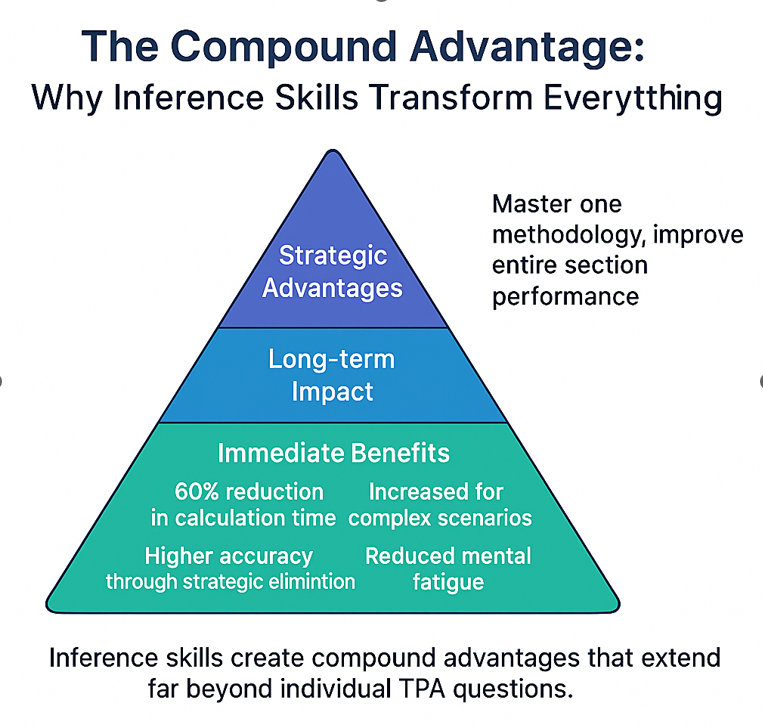
↗️ Immediate Benefits:
- 60% reduction in calculation time
- Higher accuracy through strategic elimination
- Reduced mental fatigue from unnecessary computations
⭐ Long-term Impact:
- Pattern recognition that transfers across question types
- Increased confidence in complex multi-variable scenarios
- Time savings that allow for double-checking highest-value questions
✅ Master all five Data Insights question types with strategic frameworks- GMAT Data Insights – Practice Questions
Your Next Challenge
You now have the foundation for strategic inference development. But what happens when you encounter the most sophisticated TPA questions—the multi-variable optimization problems that challenge even high-scoring students?
In our next article, we’ll tackle the optimization trap that causes smart students to get complex questions wrong. You’ll learn how to handle scenarios with 5+ variables, sequential constraints, and dynamic optimization targets.
⚡ Practice Assignment
Your Mission: Find 5 TPA questions with multiple variables. Before solving any of them, spend 60 seconds developing elimination criteria based on relationships and constraints. Notice how much more efficiently you can approach the actual calculations.
The students who break through to elite TPA performance don’t just calculate better—they think strategically first. Starting now, you do too.
⭐Transform Your TPA Performance Today
Ready to move beyond calculation errors and master strategic inference development? Our comprehensive TPA preparation includes:
- Advanced inference frameworks for multi-variable problems
- Pattern recognition training across all TPA question types
- Time-management strategies that eliminate calculation dependency
- Adaptive practice technology that builds strategic thinking skills


